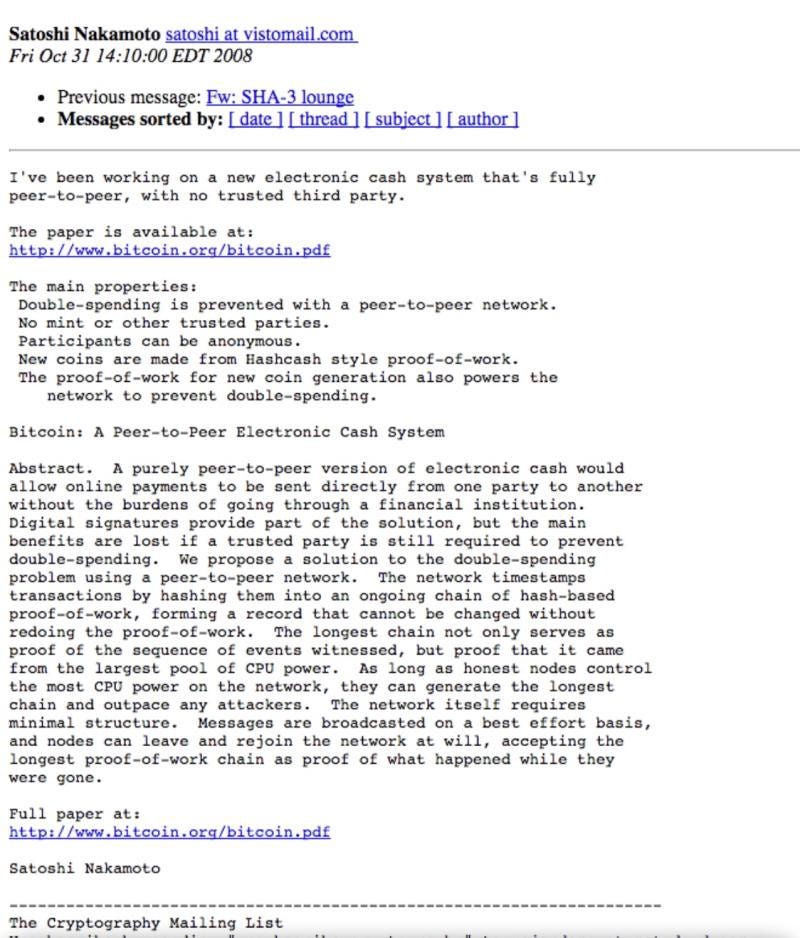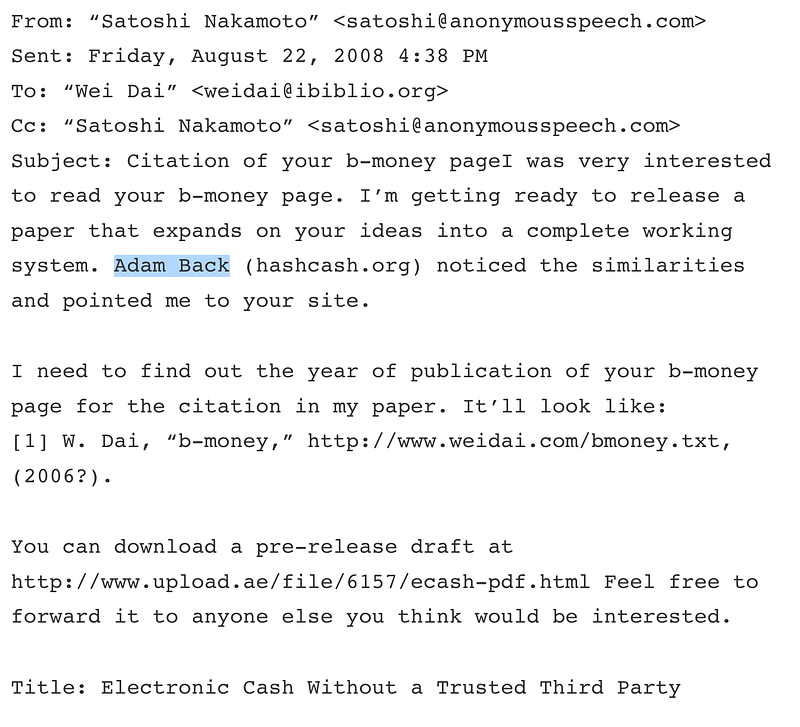Bitcoin … Becomes a Teenager

Bitcoin … Becomes a Teenager
Today is the 13th anniversary of a machine that showed the world a new way of transacting:

and which outlined a paper which is still relevant to this day [here]:

Who was Satoshi?
In 2020, there was more light shed on Satoshi with an analysis around the Wayback Machine on Bitcointalk posts, emails, code commits, and related data [here]:

This included 742 posts over 206 days, and which ended on 13 Dec 2010:

By analysing the times of the activity we can see that Satoshi may have been sleeping from 4am to 2pm (UK time). If we take 4pm UK time as the time he may have started his work (approx 9am), there may be a seven-hour difference, and which would place him around US Pacific (PST).
But, if we think that he had a day job, and did the work in the evenings, we end up with a different analysis, and where he finished work around 5pm, and then started on Bitcoin development. This would possibly place him in the UK. A further analysis saw that Satoshi made 169 code commits around the same time period. Each of these time commits with defined with UTC. A recent study in 2018 found that Satoshi’s commits were often related to “British Summer Time” timestamps. So here is a possible scarious, where Satoshi awoke around 7am and went to work in the UK, and then left work around 4pm, and set off home. Once there he focused on creating Bitcoin 1.0, until around 12pm, when he sometimes worked late, but would also get some sleep:

A very British person?
So, the UK is a strong possibility, and this is strengthed by the data in the genesis block’s on 3 January 2009, and which outlined a news item from The Times:


In 2009 the on-line version of the paper carried a different version of the article, so Satoshi may have actually bought the paper, and where it is unlikely that he would have been able to source this in the US.
There has been much debate to about his spelling of works that favoured the British stype, such as using with -ise instead of -ize, such as with analyse and organise, and by adding an ‘o’ to neighbour and colour. But his usage of the word ‘bloddy’ definitely points of someone in the UK, as there are few places in the world which use the word [here]:

And also have a look at this:

What do you see? Well, it has a British spelling of “honour” and uses double space breaks. It seems that Satoshi might not be from the US, and that the usage of British spelling and double spaces could point to one person: Adam Back — the current CEO of Blockstream. Adam has a long track record of innovation in cryptography and cryptocurrency, including creating Hashcash in 1997, and which was finally written-up in 2002 [here]:

He is also a well-known as a cypher punk and even produced the following T-shirt as a protest against export restrictions related to the RSA method:

In fact, Satoshi even mentions Adam in an email from 2008, and one way of reading this is that Adam knew about the similarities, and was hiding behind the Satoshi pseudonym:

And he was referred to in the Bitcoin paper:

Hal Finney
So, with all the debate around the bitcoin creator, let’s not forget the not-to-be-forgotten researcher who actually helped to built and implement the original infrastructure — Hal Finney.
The memory of Hal Finney has been rekindled over the debate on the creator of Bitcoins. He was actually the person who received the first transaction of 10 BTC from Satoshi Nakamoto, and was the person who created the first proof-of-concept of the cryptocurrency. In helping to create Bitcoins, he helped create a fascinating jumble of crypto that works surprisingly well:

A true Cyber Punk
If there’s one name that appears so often in the history of cryptography for someone that many people respected it is Hal. Here is an acknowledgement from Daniel Bleichenbacher (Bell Labs) on the publication of his classic attack on SSL [here]:

Hal was also the second developer hired for the PGP Corporation, after Phil Zimmerman, and he is quoted that he loved the technology as it protected the rights of individuals to privacy. He remained there until his retirement in 2011.

Hal was completely enchanted by the magic of cryptography and his Web page announced:
Much of my free time and effort these days are devoted to my activities in cryptography. In the past, I have participated actively on the Cypherpunks mailing list. Cypherpunks Archives seem to go down suspiciously often; too much “burn before reading” stuff there, I guess.
and for PGP:
I was one of the original programmers on PGP version 2.0, working directly with Philip Zimmermann, author of the program. Today, I work for Network Associates, developing the crypto library for the commercial version of PGP.
His key contributions were often his posting to the cypherpunks listserv, and was involved in a range of cryptographic activism, such as running a contest to break the export-grade encryption that Netscape used for SSL. He successful broke SSL, and showcased the major weaknesses of the technology.

His work on bitcoins came in 2004, and he produced the first proof-of-concept for bitcoins, and we continued to work on it until his death in 2014. His illness — Amyotrophic Lateral Sclerosis (ALS)- was announce in 2009, and, by 2013, he was essentially paralyzed, but he continued to program and push forward cryptography. His death arrived on 28 August, 2014, and he was cryo-preserved by the Alcor Life Extension Foundation.
His crypto challenge to break SSL was published in August 1995, where he posted a sample of a capture, and within a short time the 40-bit secret part of the key was found within 8 days (half the key space) using 120 workstations at INRIA, Ecole Polytechnique. The solution was posted here.
The godfather of Bitcoin?
On 3 January 2009 at 6:15pm, something amazing was born, and Hal played a key part in the testing of the newly created infrastructure:

The emails from Satoshi to Hal are now a key part of the history of Bitcoins:

and who would believe it, but the initial code was developed on a Microsoft Windows platform with references to MSVC60.DLL:

The emails show that Satoshi Nakamoto was the main developer, and Hal was basically the tester of the first version. Some think that Hal was Satoshi, but the email show otherwise.
Even so, others say that he faked the emails in order to cover his tracks. The mystery gets even stranger when you find out that a someone named Satoshi Nakamoto lived just two miles away from Hal (and who isn’t the actual creator of Bitcoins). Did Hal just look up the phone book and pick Satoshi as the fake creator, where he was the real creator. At the time, those involved in creating Bitcoins were worried that they would be arrested for creating an infrastructure which was a threat to the US Dollar, and hide their tracks.
His last days
Unfortunately Hal spent his last weeks — in August 2014- before his death faced with an extortion attempt of 37.63289114 bitcoins (exactly $20,000) from a hacker named “Nitrous,” “Savaged,” and “Clerk1337”, and who threatened to publish personal details on-line. The hacker outlined, ‘… there is nothing you can do to have me caught. I need to raise funds for my mother.” There were other attempts of extortion against Hal, including one for 1,000 bitcoins ($400,000), on the posting of his family’s health data on-line.
Finney believed in extropianism beliefs, and has been cryogenically frozen, with a hope to be revived at some time in the future.
Conclusion
Well, will we have a troublesome teenager or an agreeable adult. One thing that is for sure, it that trusted transactions are not going to go away, and Bitcoin was just the start. To me, it is the Ford T of blockchain, and showed the way, but there is much better methods coming though, and which can properly secure the Internet.
Postscript
Please consider donating some of your cryptocurrency to help support the families of those affected by Amyotrophic Lateral Sclerosis (ALS):
https://www.coindesk.com/community-honors-hal-finney-bitcoin-fund-als-research/